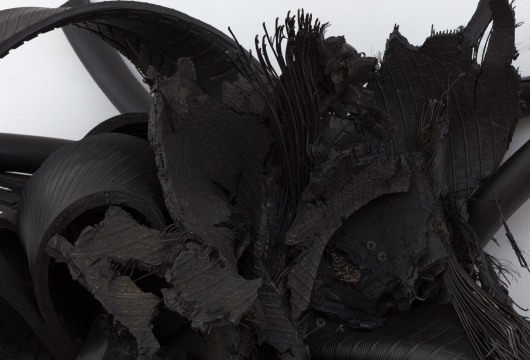
Chakaia Booker
(b. 1953)
Pause, 2023
tapestry
72 x 108 in (182.9 x 274.3 cm)
edition of 3
(CHB8955)
Chakaia Booker
(b. 1953)
Revolving Suspicion, 2023
rubber tires and wood
26 x 30 x 10 in (66 x 76.2 x 25.4 cm)
(CHB8957)
Chakaia Booker
(b. 1953)
The Host, 2023
rubber tires, wood, and steel
33 x 32 x 35 in (83.8 x 81.3 x 88.9 cm)
(CHB8959)
Chakaia Booker
(b. 1953)
Time Spent, 2023
rubber tires and wood
18 x 30 x 8 in (45.7 x 76.2 x 20.3 cm)
(CHB8958)
Chakaia Booker
(b. 1953)
Untitled, 2023
woodblock, lithograph and hand-painted chine collé with embossment
40 3/4 x 28 1/8 in (103.5 x 71.4 cm)
framed: 44 1/4 x 31 7/8 in (112.6 x 81 cm)
unique
(CHB8949)
Chakaia Booker
(b. 1953)
Added Substance, 2008
rubber tires and stainless steel
96 x 45 x 57 in (243.8 x 114.3 x 144.8 cm)
(CHB8956)
Chakaia Booker
(b. 1953)
Untitled, 2023
woodblock, lithograph and hand-painted chine collé with embossment
46 1/2 x 30 in (118.1 x 76.2 cm)
framed: 50 1/8 x 33 5/8 in (127.4x 85.5 cm)
unique
(CHB8948)
For the 2023 edition of The Art Show organized by the Art Dealers Association of America at the Park Avenue Armory, David Nolan Gallery is delighted to announce a solo presentation of American artist Chakaia Booker. For the first time ever, Booker will present textile art, in the form of a magnificent large-scale tapestry. This new work is inspired by an evolution of her paper collages.
To further convey the artist’s unique process, the exhibition will feature a variety of media Booker has adopted in her practice over time, such as paper collages and rubber tires, the artist’s signature approach to abstraction, developed over the last four decades. Booker, a fixture of the New York City East Village art scene since the early 1980s, is best known for her pioneering use of recycled rubber tires as a raw material for making abstract sculpture, often at a monumental scale.
A delicate grace balances the power of Booker’s classic wall and free-standing sculptures. Made from black rubber tires, they evoke political and social aspects, from the patterns of the tires alluding to African scarification, to the exploitation tied to the collection of rubber, and the history of low wages African American workers received in the automobile industry. Booker’s works look back to the social upheaval of the 1960s and the awakening of American society to the continuing plight of Black Americans 100 years after slavery had been abolished.
There are visual parallels with the tire tread patterns and shapes of the sculptures in the paper collages. Booker has revolutionized the way drawings and prints are made when using the chine collé technique. She reinvented this process to serve her own creative desires to increase the number and transparency of layers, allowing marks, colors, and materials to blend into one another. Booker often activates the surface of her works on paper through embossment, a direct visual foil to black rubber tire treads.
Chakaia Booker’s work is held by numerous institutions around the country, and has had a wide influence on younger artists.
